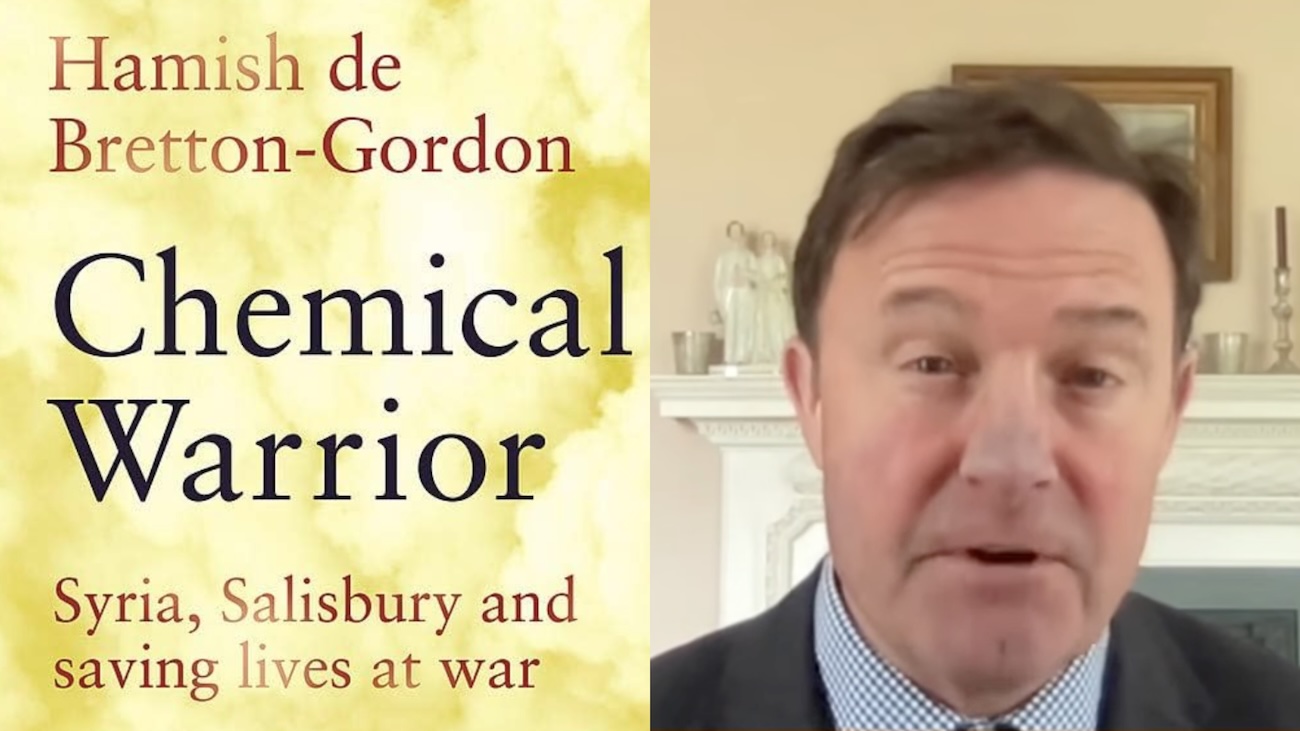The Evolution of the Syria Chemical Weapons Narrative and the Road to Ghouta
Author's Note: The allegation that the now-deposed Syrian Government systematically deployed chemical weapons against civilians during the 2011-2020 war is oft repeated widely by Western politicians, mainstream media, think tanks, and “regi

We have tagged this article as propaganda as it imposes a serious spin on the topic.
If not more explanation provided, this article is included as propaganda because it shows clear manufacture from a government controlled dialectic,
where a topic is misdirected by some actors in order to mislead people during early stages of a narrative.
Author's Note: The allegation that the now-deposed Syrian Government systematically deployed chemical weapons against civilians during the 2011-2020 war is oft repeated widely by Western politicians, mainstream media, think tanks, and “regime change” activists. These claims have been supported, to varying degrees, by the world's premier chemical weapons watchdog, the Organisation for the Prohibition of Chemical Weapons (OPCW). In 2019, however, whistleblower scientists from within this organisation testified to the manipulation of the investigation of one of these alleged attacks, in order to reach a “pre-ordained conclusion” that the Syrian Government was responsible. In fact, the entire history of alleged chemical weapons (CW) incidents in Syria, dating back to as early as 2012, is controversial. This series explores the history of these allegations and sets out a preliminary case that the entire CW narrative is, in fact, a strategic deception designed to underpin a policy of “regime change” by delegitimating the Syrian Government.
Part 1 of this series examined the case of an alleged nerve agent attack in Homs in December 2012. This well-publicised alleged attack, complete with video of hospital scenes and testimonies from medics, was one of the most prominent of the early chemical weapons (CW) allegations and occurred in the context of the US Obama Administration, having declared a “red line” regarding CW use whereby, if crossed, overt US intervention would follow (I write overt because the US was already trying to overthrow the Syrian Government via a massive covert CIA operation called Timber Sycamore). The alleged nerve agent attack, was, however, rapidly discredited when it became apparent no such attack had occurred and that erroneous information had been channelled, in part, via a UK Government-funded propaganda operation.
It would not be long before the CW issue surfaced again. On 19 March 2013, there was an alleged chemical weapons attack launched on the town of Khan al-Assal, killing 16 Syrian soldiers. The day after, the Permanent Representative of the Syrian Arab Republic addressed a letter to the President of the UN Security Council requesting a "specialized, impartial independent mission to investigate the alleged incident”.
On 21 March, the UN Secretary-General established the United Nations Mission. As William Van Wagenen documents in Creative Chaos: Inside the CIA War to Topple the Syrian Government (forthcoming in 2025), however, opposition forces quickly attempted to muddy the waters by blaming the alleged attack on the Syrian Government whilst, simultaneously and during the coming days, the UK, France, and Qatar relayed tit-for-tat allegations of CW use in Salquin (October 2012), Homs (December 2012), Darayya (March 2013) and Otaybah (March 2013).
As plans were developed in order to initiate deployment of the United Nations Mission into Syria, so that the investigation requested by the Syrian Government could get underway, further alleged incidents occurred. It is at this stage that evidence of UK intelligence involvement with events surfaces again (As described in Part 1, the December 2012 alleged incident in Homs had been, at least in part, via UK organised and funded influence operations ARK and BASMA). Hamish de Bretton-Gordon, a former British military officer, describes in his book Chemical Warrior how, after Khan al-Assal, he became involved in Syria when there was an alleged attack in Saraqib on 29 April 2013. He does not mention in his book, however, that he was also present following an alleged attack in Sheik Maqsood on 13 April. He certainly was present at Sheikh Maqsoud because, in a Wilton Park podcast, he subsequently described how he had worked alongside Times journalist Anthony Lloyd in order to obtain samples from this alleged incident. Later, UK media reports told of MI6 sample gathering operations during this period (see here and here) whilst British Prime Minister David Cameron referred to evidence provided by Porton Down defence laboratories and the UK's Joint Intelligence Committee which 'proved' sarin was used at Otaybah and Sheikh Maqsoud.
Ultimately, when the United Nations Mission issued its joint report with the OPCW in late 2013, nothing much was to come of the flurry of attacks alleged by the US, UK, France and Qatar (see ‘Table One: CW Allegations and Joint UN-OPCW Investigation 2013’). Of the 11 accusations levelled at the Syrian Government, nine were not investigated on the grounds of “insufficient” or not “credible” information. These included, unsurprisingly, the 2012 Homs incident discussed in Part 1 of this series. Sheikh Maqsoud, at which Hamish de Bretton-Gordon was present, was investigated, but no corroborating evidence was found to support the allegation. Interestingly, this incident was reported to the UN Secretary-General via the US, rather than the British, and, as noted above, de Bretton-Gordon does not mention this incident in his book. Only the alleged incident at Saraqib was found to have evidence that “suggested” an attack had occurred. Furthermore, in a process that will become familiar when we examine alleged CW attacks from 2014 onwards, information regarding these alleged attacks had been funnelled by aligned groups such as the USAID-funded Syrian American Medical Society (SAMS) and the France-based Union of Syrian Medical Relief Organisations (UOSSM) (see Creative Chaos). At the time, a Russian UN envoy made the following comment about the flurry of allegations:
We need to look into credible allegations ... Unfortunately, I think what our western colleagues have been doing is trying to produce the maximum number of allegations with minimum credibility in an effort, one might think, to create maximum problems for arranging such investigation.
Conversely, all but one (three out of four) of the allegations issued by the Syrian government were found to have some level of supporting evidence with the original alleged attack at Khan al-Assal, which triggered the complaint to the UN, described in the joint UN-OPCW report as being “corroborated” by “credible information”.
Lloyd and Postol Study, January 2014.
Rocket trajectories, impact points and launch areas from Ghouta Sarin Attack: Review of Open-Source Evidence by Michael Kobs, Chris Kabusk, and Adam Larson, 2021.
Excerpts from video analysing-30 degree measurement error, by Michael Kobs
Read the full article at the original website
References:
- https://www.ukcolumn.org/article/homs-2012-and-the-genesis-of-syria-chemical-weapons-narrative
- https://web.archive.org/web/20250209174326/https://www.securitycouncilreport.org/atf/cf/%7B65BFCF9B-6D27-4E9C-8CD3-CF6E4FF96FF9%7D/s_2013_735.pdf
- https://www.dropbox.com/scl/fi/9ypl6226vy7ykghc6qmw0/Hamish-Wilton-Park-Recording.mov?rlkey=3u8ormnq609slhlxjthq45x6b&dl=0
- https://archive.is/sAeFd
- https://www.mirror.co.uk/news/world-news/syria-using-poison-gas-sarin-1893721
- https://www.theguardian.com/world/2013/jun/14/syria-sarin-rebels-twice-cameron
- https://www.securitycouncilreport.org/atf/cf/%257B65BFCF9B-6D27-4E9C-8CD3-CF6E4FF96FF9%257D/s_2013_735.pdf
- https://www.timesofisrael.com/russia-accuses-west-of-inventing-chemical-weapons-claims/
- https://www.lrb.co.uk/the-paper/v36/n08/seymour-m.-hersh/the-red-line-and-the-rat-line
- https://www.theatlantic.com/magazine/archive/2016/04/the-obama-doctrine/471525/
- https://academic.oup.com/psq/article/129/4/551/6846150
- https://s3.amazonaws.com/s3.documentcloud.org/documents/1006045/possible-implications-of-bad-intelligence.pdf
- http://scribd.com/document/230748990/Murder-in-the-SunMorgue
- https://www.scribd.com/document/230748990/Murder-in-the-SunMorgue
- https://libyancivilwar.blogspot.com/2014/11/the-ghouta-massacres-sarin-myth.html
- https://timhayward.wordpress.com/2017/08/31/who-is-responsible-for-chemical-attacks-in-syria-guest-blog-by-professor-paul-mckeigue-part-2/
- https://rootclaim-media.s3.amazonaws.com/syria2013evidence.pdf
- https://www.youtube.com/watch?v=9ha93zKeSFs&list=PL5oQEwTs6Z0wFySCjZ2hkL2FKAyxCp-Mi&index=3
